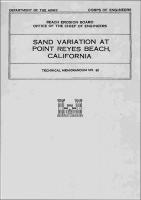Please use this identifier to cite or link to this item:
https://hdl.handle.net/11681/3451| Title: | Sand variation at Point Reyes Beach, California |
| Authors: | United States. Army. Office of the Chief of Engineers Trask, Parker D. (Parker Davies), 1899-1961 Johnson, Charles A. University of California, Berkeley. Wave Research Laboratory |
| Keywords: | Sand Point Reyes Beach, California Shore protection Beach nourishment Sand analysis |
| Publisher: | United States, Beach Erosion Board Engineer Research and Development Center (U.S.) |
| Series/Report no.: | Technical memorandum (United States. Beach Erosion Board) ; no. 65. |
| Description: | Technical Memorandum Abstract: The Point Reyes beach is a long straight beach 10 miles in length, characterized by cusps 60 to 200 feet apart, averaging about 125 feet. The cusps are superimposed upon large indentations of the shore line of as much as 200 feet in distance toward shore and 1500 to 3000 feet parallel to the shore. The indentations are opposite large rip tides. Two stations were occupied on the beach, one 3 miles northeast of Point Reyes, and the other 5 miles up the beach. These stations and a series of traverse stations in the intervening distance were occupied at three seasons: June at the end of the winter season, October at the end of the summer season, and February and March during the middle of the winter season. The sediments on the beach are highly variable and the average variation within a distance of 16 feet of selected points is 60 to 65 percent of the total variation encountered upon the beach. The grain size of the sediments at Stations A and B was not significantly different except during October, when the samples at Station A were considerably finer than at Station B. Samples taken at either station in October at the end of the summer season are definitely more fine-grained than in June or February. The sediments show a distinct relationship to position on the beach. Samples on the lower foreshore are coarse; on the upper foreshore fine; and on the berm slightly coarser than on the upper foreshore. Although the grain size varies with elevation, the variation of the samples within individual elevation zones is more or less constant. The grain size shows no variation with slope of the beach, which is a steep beach, sloping in general 6 to 12 degrees. The outer edge of the berm is 12 to 15 feet above sea level. The general grain size is 600-750 microns. The coefficient of sorting is moderately high for a beach, the general average for Station A near Point Reyes is 1.28, and 1.45 at Station B. The variability of the sorting coefficient is greater at Station B. where the coefficient is higher. The coefficient of sorting shows a poor but definite correlation with grain size. The sorting becomes poorer as the grain size increases, that is, the coefficient of sorting increases as grain size increases. A statistical study of grain size and slope of the beach definitely indicates a more or less random relationship. |
| Rights: | Approved for Public Release, Distribution is Unlimited |
| URI: | http://hdl.handle.net/11681/3451 |
| Appears in Collections: | Technical Memorandum |
Files in This Item:
| File | Description | Size | Format | |
|---|---|---|---|---|
| BEB-TM-65.pdf | 2.1 MB | Adobe PDF |  View/Open |